Legivenestatery.com is a suspicious domain that shows unwanted pop-ups and commercials on your browser due to a virus infection. It also tricks users into allowing its notifications via fake pop-ups upon loading. It can also drop malicious codes on your system which can bring more threats and viruses. This guide will assist you in removing this nasty virus from your PC easily.
Threats like Legivenestatery.com can get back on your PC if all associated files are not removed. So we advise you to use SpyHunter 5 Anti-malware to automatically detect and remove all threats from your computer at once.
Compatible with: Windows 11/10/8/7 (32 Bit and 64 Bit)
What is Legivenestatery.com virus?
Legivenestatery.com virus may be also categorized as a Potentially Unwanted Program that you don’t need but it’s not detected by your anti-virus program as dangerous. Usually, this type of application is used by cybercriminals for making illegal profits online.
Once getting into your system, this infection will deliver tons of ads and leads your browser to shady websites with fake alerts and notifications. Numerous banners, scam offers, pop-ups, deals, etc. will be lying around and asking you to click. All these ads are used to trick people and install malware on their computers.

Legivenestatery.com infection is commonly referred to as a redirect virus due to those forced web redirections. Most people may only consider this activity as annoying but it also exposes your system to various risks and malware infections. This dubious threat causes users to visit suspicious websites where they may get asked to allow push notifications. Chances are very high that your computer will catch some nasty malware in the process without your knowing.
Malicious codes that run on those sites could drop threats on your system that will cause further unwanted web redirection. Following that, you may also encounter a massive amount of pop-up ads on your Windows or Mac due to this virus. Clicking on any suspicious push notifications could result in browser redirects to potentially dangerous websites.
In addition to the above problems, the excessive magnitude of ads can use large amounts of CPU resources. Your system will get extremely slow and the browser often gets stuck for no reason. Legivenestatery.com virus will leave a tiny amount of CPU power for all the other essential activities which cause a significant drop in your system performance. Apart from that, those ads may also cause major disturbance to your regular and leads to frustration through forced redirection of your browser.
Redirect Malware causes privacy issues
If you are not aware of it, you should know that redirect viruses can cause serious privacy issues. The majority of landing pages that host malicious codes collect the personal information of the users upon visit. These collected details may include users’ browsing history, Geographical locations, passwords stored on the browser, IP addresses, most frequently visited website details, and much more. All this info can be used by Legivenestatery.com to show personalized ads on users’ computers or distributed to third parties for illegal profit-making purposes.
Most of the rogue applications and malware creators show much interest in buying such kind of information. You may have noticed in real life that you get so many calls and emails from unknown companies, so how do they get your information if you don’t know them? They obviously buy your data for marketing purposes. The same goes here, hackers buy data in bulk and launch their malware to target users according to the data.
Legivenestatery.com or other similar threats collect and sell your information to other malware or rogue website creators. Then they will start sending you ads as well and soon your system will get flooded. These ads allow developers to get more clicks on their sites which leads to a significant increase in their revenues. However, these ads could also be used to spread malicious codes by criminals.
Legivenestatery.com: Threat Analysis
| Name | Legivenestatery.com |
| Type | Redirect Virus |
| Threat Level | High (source to distribute other harmful threats). |
| Symptoms | Users can experience changes in their browsers and an excessive amount of annoying pop-up ads. |
| Distribution | It could be distributed through spam emails, bundled freeware, porn, or torrent sites. |
| Damage | It can modify browsers, show unwanted Ads, steal personal info, and bring other threats. |
| Removal | Download SpyHunter 5 Anti-Malware |
Legivenestatery.com can spread through various means
You must be thinking about how this Legivenestatery.com infection first got into your system. Well answer to that question is pretty simple. Browsing to unknown sites and clicking on misleading pop-up ads or allowing push notifications are primary methods. Additionally, many freeware program creators bundle third-party codes to earn extra bucks on the side, so it’s another way.
Apart from that downloading pirated content like software, movies, etc. from torrents or similar sources then your PC gets infected. If you browse porn sites or share files on unsafe networks then you could also end up getting similar threats on your system. So you must be careful and use extra precautions to avoid infiltration of any suspicious programs or malware.
Stop suspicious redirects by Legivenestatery.com website
If this dubious infection has already infiltrated your computer then you should immediately remove Legivenestatery.com virus to put an end to further damage. You will need to stop all the upcoming pop-ups, push notifications, alerts, and all the other kinds of ads. It might not be as easy to get rid of this virus, so we encourage you to take the help of a powerful malware removal tool.
After that, you will need to reset the settings of your browsers like Google Chrome, Firefox, Edge, Safari, IE, and others. We have created an elaborate guide with step-by-step instructions to help you. You must take immediate action to avoid any financial loss or significant security breaches.
How To Remove Legivenestatery.com
We have created a step-by-step guide for you to remove Legivenestatery.com virus easily from your computer. Follow the instructions carefully to remove this threat completely from your system. Use SpyHunter 5 Anti-Malware to remove the infection automatically if you don’t want to use the Manual removal method.
Quick Summary of Removal Instructions:
- Remove Legivenestatery.com with SpyHunter
- Uninstall Legivenestatery.com from Control Panel
- Remove Legivenestatery.com From Browser
- Reset Browser Setting to Default
- How to prevent malware attacks in future
You may have to restart your computer or browser, so Bookmark This Page by pressing the Ctrl and D buttons together before you begin the removal process.
Remove Legivenestatery.com with SpyHunter
Removing threats and viruses manually from a computer can be hectic but SpyHunter 5 Anti-Malware can make this task much simpler. It can help you find and delete all kinds of threats like Trojans, Ransomware, Spyware, Adware, PUPs, etc. easily from your PC. You just have to install the application and run a new scan on your PC.
It will easily find Legivenestatery.com virus and all other hidden threats and remove them efficiently in no time. You will also get 24X7 customer support and Custom Malware removal via one-on-one Spyware HelpDesk support. SpyHunter can block threats in real time via its advanced System Guard feature. It is compatible with your anti-virus application and fills the security gaps to provide the best protection.
How SpyHunter 5 Anti-Malware Works
- First, you will need to download the SpyHunter Installer on your computer. The below download button will take you to the download page in a new tab, so this guide will be still accessible to you.
Threats like Legivenestatery.com can get back on your PC if all associated files are not removed. So we advise you to use SpyHunter 5 Anti-malware to automatically detect and remove all threats from your computer at once.
Compatible with: Windows 11/10/8/7 (32 Bit and 64 Bit)
- The SpyHunter-Installer.exe file will get downloaded on your PC. Run the installer via a double-click to start the installation and follow the instructions to complete the setup.

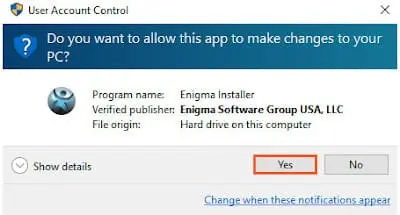
- Launch SpyHunter 5 Anti-Malware after the installation if it does not automatically starts. Now you will have to click on the Start Scan Now button to detect all hidden threats and viruses on your PC.
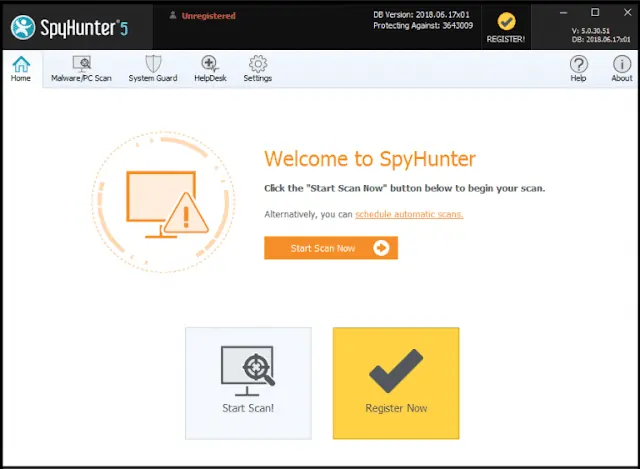
- Once you start scanning your system, wait for a few minutes. The software will run a thorough diagnostic of your PC and give you a detailed report of all the threats found on your PC.
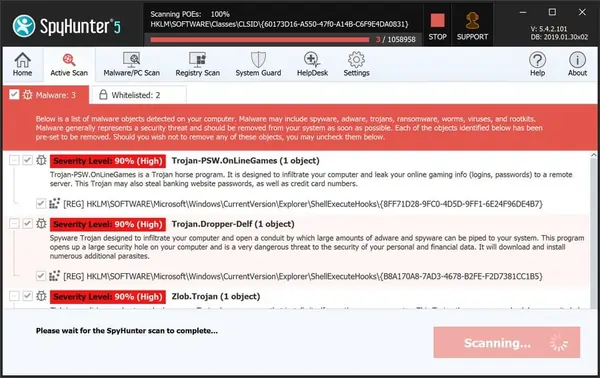
- After the scan, a complete list of all threats will be shown to you. Finally, you will just have to click on the Next button to immediately remove all the threats at once.
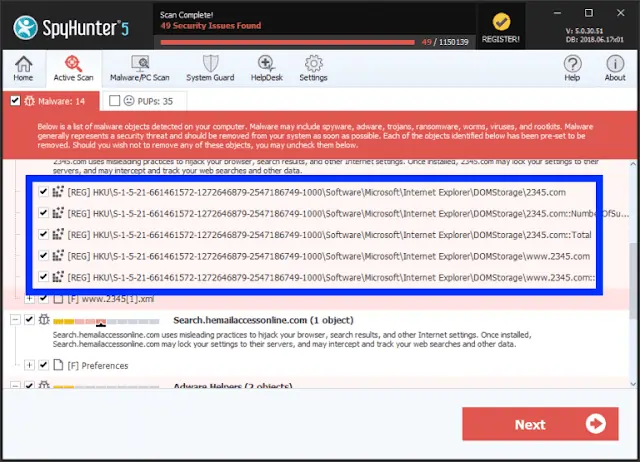
Uninstall Legivenestatery.com from Control Panel
- First, you need to press and hold the Windows key and then hit the R button.
- Soon you will see the Windows Run Box on your computer screen.
- Now type or copy-paste appwiz.cpl in the run box and click the OK button.
- You will see the Programs and Features windows with a list of all installed applications.
- Find any unknown or suspicious app related to the virus and then press the Uninstall button.
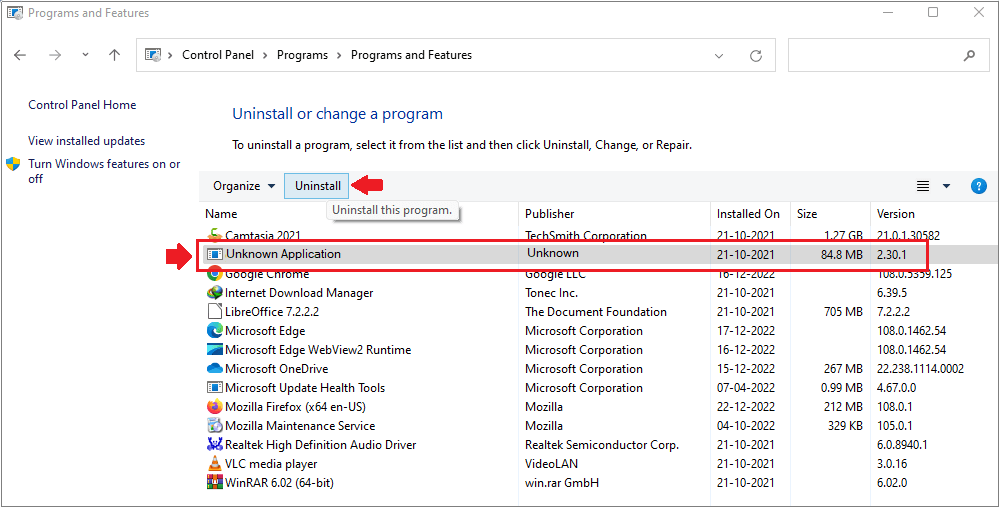
Remove Legivenestatery.com From Browser
This threat tricks users into allowing push notifications by altering the browser settings. You need to reverse the changes made by this infection to stop those unwanted pop-up ads and redirects.
It will take some doing but very much possible. However, if you are using the Anti-Malware application, it will be done automatically. But still, we have created a detailed manual guide and the below steps can help you reverse the browser settings.
Google Chrome
- Go to the Google Chrome menu by clicking on the (⋮) icon from the upper right corner of the browser.
- Press on the Settings button from the right-side drop-down menu.
- Choose the Privacy and Security option from the left sidebar on the settings page.
- Now click on the Site Settings option and then open the Notifications tab.
- Here you can see the list of websites showing pop-up ads on your browser.
- Find the malicious website causing trouble, click on the (⋮) icon next to it and press the Remove button.

Mozilla Firefox
- Access the Mozilla Firefox menu by clicking on the (☰) icon from the upper right corner of firefox.
- You will see a drop-down menu there, click on the Settings option.
- Click on Privacy & Security from the left sidebar on the settings page.
- Scroll down and open the Notifications settings option on this page.
- A list of all websites with permission to show notifications on your browser will appear here.
- Select the malicious website and click on the Remove Website button.

Microsoft Edge
- Open the MS Edge menu by clicking on the (…) icon from the upper right corner of the edge browser.
- A drop-down menu will show on the right side of your browser instantly.
- Scroll down and look for the Settings option and click on it.
- Click on the Cookies and site permissions option from the left sidebar.
- Open the Notifications option to see the sites causing trouble.
- Find the malicious website, click on (…) icon and press the Remove button.
- You can do the same process with the Pop-ups and redirect settings also.

Safari Browser
- Open Safari Menu by clicking on the Safari button from the top left side right next to the apple icon.
- The browser settings menu will appear as a drop-down list instantly.
- You will have to click on the Preferences option from the list.
- Open the Website tab and then click on the Notifications option on the left side.
- You will see the list of all the websites showing notifications on this page.
- Now select the malicious site and click on the Remove button.
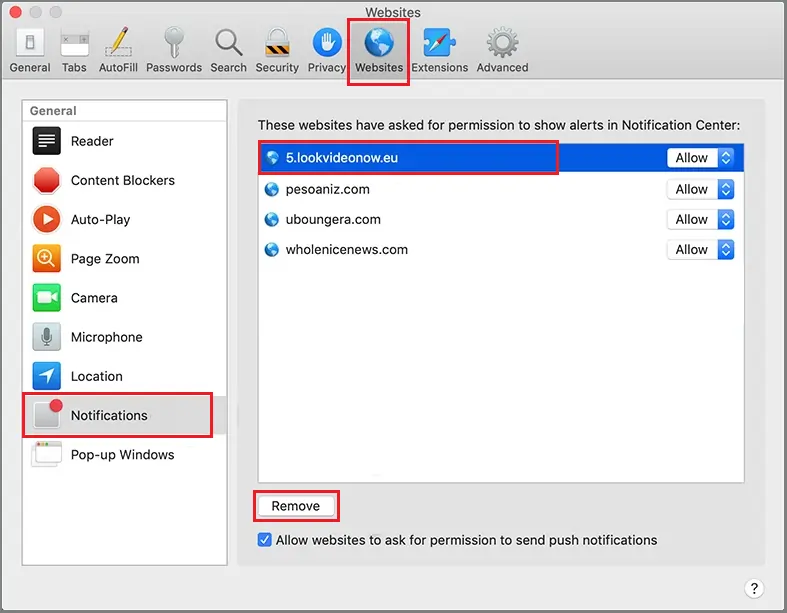
Reset Browser Setting to Default
You should also reset your browser settings to default after removing the Legivenestatery.com virus. Follow the below steps to undo all the changes made by the virus to your browser settings:
Reset Google Chrome
- Open Chrome’s Menu (⋮) from the upper right corner as explained earlier.
- Find and click on the Reset and Clean up option from the left menu.
- Press the Restore settings to their original defaults option.
- Finally, click on the Reset Settings button to reset your browser.

Refresh Mozilla Firefox
- Open Firefox Menu (☰) from the upper right corner as explained above.
- You will again see the drop-down menu on the right side of your browser.
- Press the Help option from the list to open the Firefox help menu.
- Now click on the More troubleshooting information option.
- Finally hit the Refresh Firefox button to reset your browser settings.
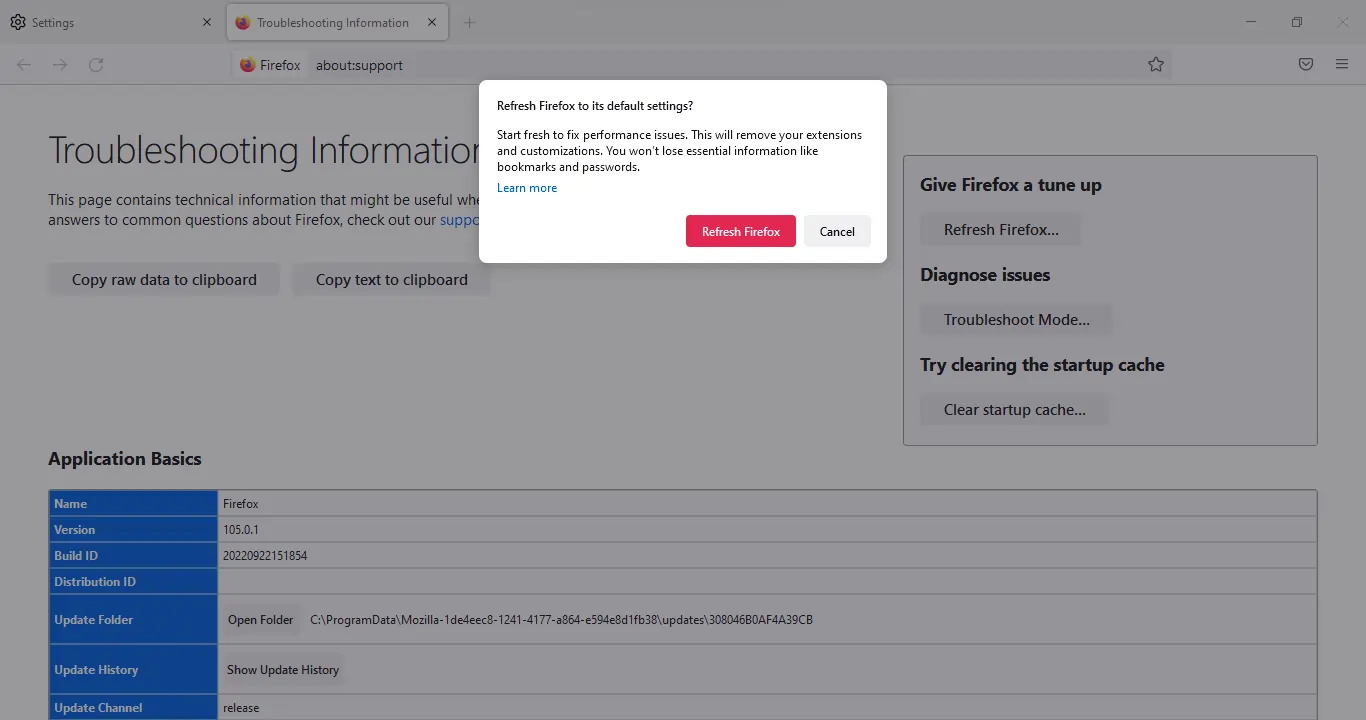
Reset MS Edge Browser
- Click on the More Tools (…) option on Microsoft Edge from the upper right corner.
- A drop-down menu will instantly appear on your browser screen.
- Find and click on the Settings option from the Edge drop-down menu.
- Click on the Reset Settings option from the left side menu.
- Hit the Restore settings to their default values option.
- Finally, press the Reset button if your browser asks for permission.
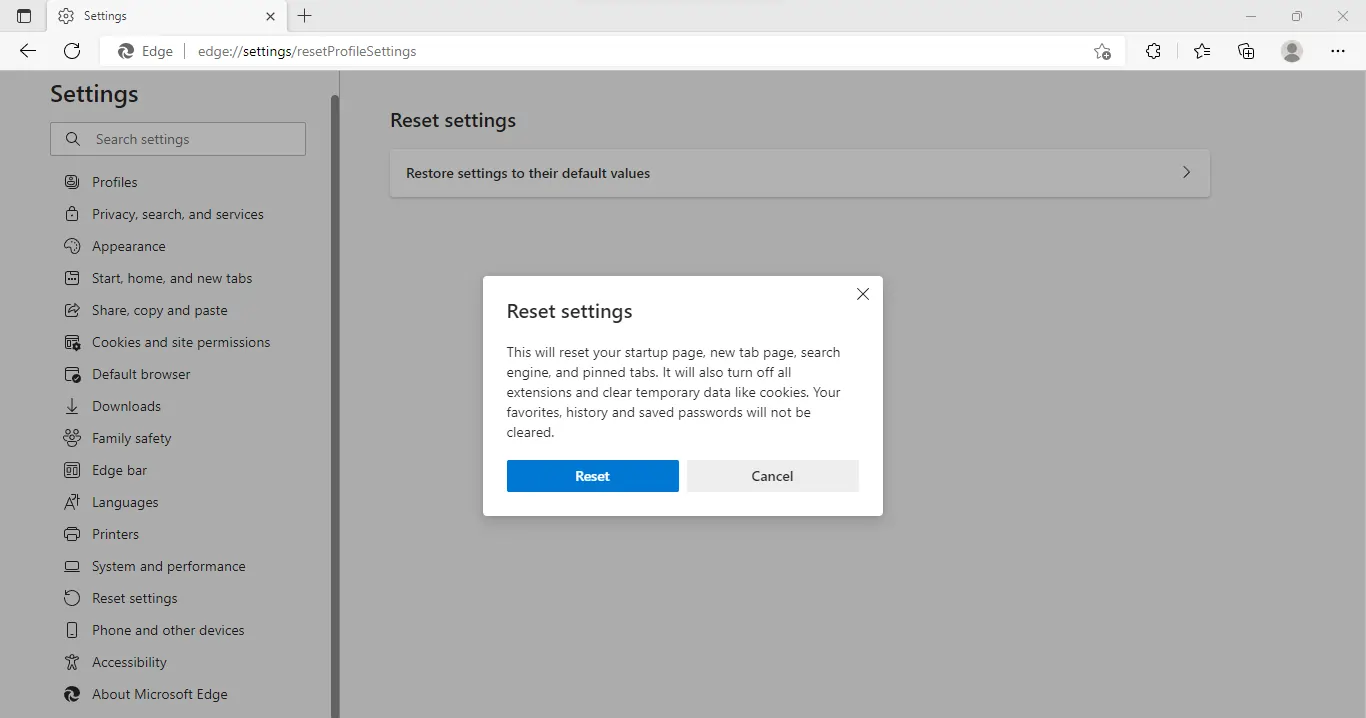
Reset Safari Browser
- Click on the Safari menu from the top of the browser right next to the Apple logo.
- You will see a drop-down menu right there when you will click on the Safari menu.
- Click on the Clear History and Website Data option from the menu.
- A new dialogue box will appear saying Clearing will remove history, cookies, and other website data.
- Finally, click on the Clear History button to clear all the data and reset your browser settings.
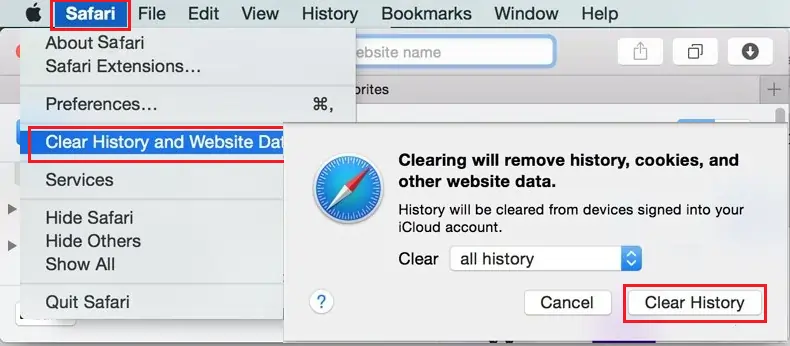
Your browser will get back to its default settings once you perform the above steps to reset your browser. Rest assured it will not delete your saved passwords or bookmarks. All the unwanted pop-ups and browser redirections should stop now.
How to prevent malware attacks in future
- Use a powerful Anti-Malware or Anti-virus program. Also, keep your security program updated to fight against the latest threats. Free Anti-virus does not offer the best protection and fails to remove dangerous threats. Do not look for cracked security programs or they will do more damage than good.
- Keep your Windows OS and other programs up to date. Updates are often launched to patch vulnerabilities that cybercriminals use to attack computer systems. So always keep your OS and programs updated. Only download updates from official sites or reliable sources.
- Only visit secured websites. Check the HTTPS and padlock icon before entering your email, password, credit card details, etc. into any site. Do not visit sites that do not have SSL security. Also, don’t forget to Enable Phishing and Malware protection in Browser.
- Do not download pirated software, games, or illegal patches. Avoid using shady sites to acquire freeware programs because they often use software bundling. Never install a program that asks you to inactivate your anti-virus software. Always choose the advanced or custom installation to avoid bundled malicious applications.
- Avoid opening spam emails from unknown senders. Cybercriminals often use spam emails to spread malware online. Always scan all the email attachments before opening them. Never click on any suspicious links with some too-good-to-be-true offers.
- Stay away from unsafe free Wi-Fi. Connecting your PC or mobile devices to unsafe public Wi-Fi is not a good idea. You can also avoid unwanted threats coming from malicious sites by using a VPN to spoof your connection.
- Back up your personal files and data. Keep regular backups of all your important data on external hard drives or cloud drives to avoid data loss in case of a ransomware attack. Also, create a system restore point on your system for security purposes.

Leave a Comment